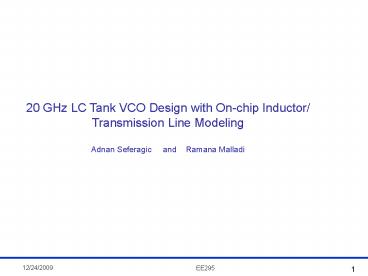20 GHz LC Tank VCO Design with Onchip Inductor - PowerPoint PPT Presentation
1 / 17
Title:
20 GHz LC Tank VCO Design with Onchip Inductor
Description:
... frequency and bandwidth of data communications. 12/21/09 ... A ve Resistance implemented using a cascaded ckt of 2 EFs, with Resistive Output Load (RL) ... – PowerPoint PPT presentation
Number of Views:78
Avg rating:3.0/5.0
Title: 20 GHz LC Tank VCO Design with Onchip Inductor
1
20 GHz LC Tank VCO Design with On-chip
Inductor/ Transmission Line Modeling Adnan
Seferagic and Ramana Malladi
2
Outline
- VCOs in Wireless Transceivers and PLLs
- Different components of a VCO
- Varactor and Inductor design and Modeling
- Limitations with Lumped element Inductors
- CMOS vs Bipolar
- Simple Cross-coupled VCO and Its Limitations
- Possible VCO Designs for High-frequencies
- Conclusions
3
Other Applications of High-Frequency VCOs
- Demands for ever-increasing frequency and
bandwidth of data communications
4
Challenges with High-Frequency Wireless Designs
- We need High-speed Transistor Technology
- We need High-Q inductors and Varactors
- Designs require Larger Chip area
- Very sensitive to Parasitics
5
Varactors
- Varactor Bias-dependent capacitor
- PN-diodes, Schottky, MOS Caps can be used as
Varactors - Junction Cap Variation is given by
- Varactor should have
- High Tunability (3 or greater )
- Quality Factor, Q, must be high (20 or greater)
- Device must exhibit linearity
6
Simple Inductors
Groves et.al., WCM-2007
7
Transmission Lines as Inductors
The impedance anywhere along a terminated T.Line
is
Z0
ZL
l
If the transmission line is lossless, a0
8
Transmission Lines as Inductors and Capacitors
9
Bipolar Vs CMOS Designs
- FETs
- gm for FETs is one decade smaller than Bipolars
- gm, Vth uncertainties
- Lossy Substrate
- Higher 1/f noise
- Higher thermal noise
- Bipolars
- Very high-speeds are achievable even at lower
nodes - Can utilize high-resistivity substrates gtbetter
Q inductors - Very low 1/f noise gt lower phase-noise for
VCOs - Very low high-frequency Noise figure
For this project we will be using CMOS. This
presentation mixes both technologies
10
Limitations with Cross-Coupled Topology at High
Frequencies
- The losses of the LC tank are represented by Rt
- The ve Resistance Rp is needed to compensate
the losses - Rp-2/gm at low frequencies. Rp is ve upto a
maximum frequency fcross - fV is input bandwidth of the npn (mainly from
the Rb and Cbe and Cbc) - (bandwidth from the collector when applying a
voltage source between Base and Grounded Emitter) - fcross 25GHz in a 70GHz technology
11
Cascaded Emitter Followers With Resistive Load
Topology
Veenstra et.al., ISSCC 2004
- A ve Resistance implemented using a cascaded
ckt of 2 EFs, with Resistive Output Load (RL) - RL of output EF (T2) translates into a
capacitive load for input EF T1 and - the capacitive load of EF-T1 translates into a
ve resistance at the base of T1 - The maximum attainable oscillation frequency for
this topology is flimit (gtfcross)
CLTotal capacitance at the output of the EF-T1
(Cin-T2Cbc..)
12
General Design Approaches
13
Push-Push Oscillator Operation
- Requires the Transistors operate in only the
odd-mode - This is assured by proper choice of Terminating
- impedance and Gain at fundamental
- Oscillation condition -Rq gt Rs
- Frequency of Oscillation -Xq(XL-XV)0
- The transistors oscillate out-of phase with each
other, - causing f0 to cancel out and 2nd. Harm. to add
in phase - To eliminate the possibility of oscillation in
even-mode, - -Rq lt Rs 2.RL
- In Summary, Rs lt -Rq lt Rs2.RL
- These conditions are easy to meet
Smith , MTT-S Digest , 1989 (725-728) Kobayashi,
JSSC, 1999 (1225-32)
14
Schematic of a D-Band CMOS VCO
- M1 and M2 with Lg, Cs provide ve resistance
- Ld and Cvar form the LC-tank resonator
- Ls Cs (source resonator) provides ve R at
freq. where - CMOS does not have enough gm to provide ve R
15
Conclusions and Directions for Future Work
- Several choices of VCO Topology exist for 20 GHz
Designs in CMOS - We will make choice based on whether the designs
are in 0.13 um or 0.25 um - and the specs we are designing to.
- Transmission Lines (CPW or Microstrip depending
on kit) will be used for the Tank
16
(No Transcript)
17
(No Transcript)




















![ProMec Engineering launch its new product air receiver tank [Press Release] PowerPoint PPT Presentation](https://s3.amazonaws.com/images.powershow.com/9238305.th0.jpg?_=20190318088)










